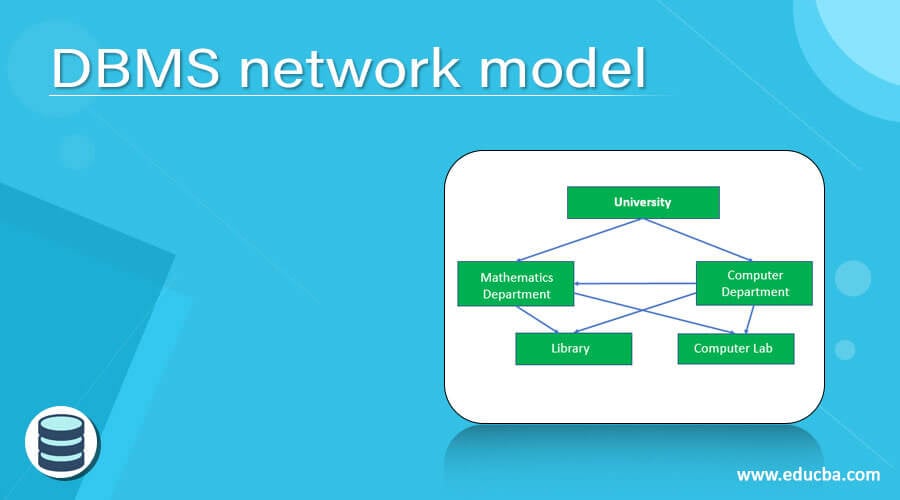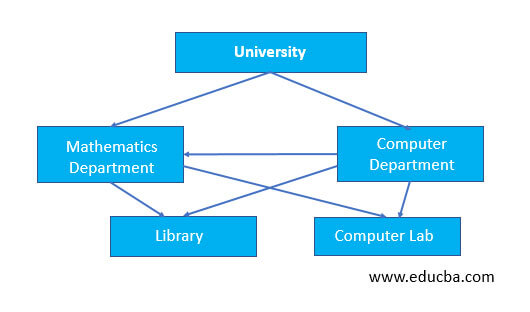Updated March 10, 2023

Introduction to DBMS Network Model
- Basically, DBMS Model is the representation type that defines the logical structure of a database and the way that regulates the behavior for data storing, forming, and operating. Some of the commonly used DBMS Models include Hierarchical Model, Relational Model, Network Model, Object-Oriented Data Model, Entity-Relationship Model, and a few others that are not the most popular.
- Therefore, DBMS Network Model is defined as an extension of the DBMS model known as hierarchical structure as it permits many to many relationships that are to be organized in a tree-like structure allowing many parents.
- The DBMS Network model comprises of two essential concepts mentioned as follows:
- Records consist of fields that require hierarchical organization.
- Sets are implemented to state one too many relationships between data that include only a single owner with many members.
How DBMS Network model work?
The network model was designed for illustrating composite relationships of data more usefully rather than the hierarchical model, to enhance database performance and to enforce a database standard.
In this type of network model, the operator observes the network databases which work as a group of data records having one too many(1:M) relationships. Nevertheless, not like the hierarchical model, this network model permits a record to prevail more than single-parent.
However, today the network model is not applied in use, but the explanations of database standard thoughts which appeared with the network model are implemented still by the current data models.
Some significant ideas that were started at this time are listed below:
- Schema, that defines the conceptual structure of the whole database as observed by the DBMS administrator.
- Subschema, that states the part of the database server “seen” by the application command programs which truly generate the preferred evidence from the data comprised inside the database.
- The DML (Data Manipulation Language) query language, which denotes the situation in which records can be organized and function with the data info in the database.
- The schema DDL (Data Definition Language), that supports the database administrator for stating the schema modules.
Basically, the network model can be considered as a flexible technique of demonstrating objects and their associated relationships. It includes a distinct feature that the schema is observed as a graphical diagram where the objects denote the nodes and relationships are determined by arcs and is not constrained to be a lattice or hierarchy.
For an instance, let us view the network model for a simple example of the university and its objects linked to it described as follows:
Fig. DBMS Network Model for the system describing University process
In this type of model, the ownership is stated by the graphical direction where all the sets consist of a general directed graph. Here, a set is developed by means of circular linked lists having one record kind where the owner of the set is a parent appearing only once in every circle and the second record kind defines the child nodes that may be seen multiple times in every circle. Access to data records is created by the indexing design of circular linked lists.
Below are certain features describing the DBMS Network Model as follows:
- Facility to Unite more Relationships: In this network model, as there are present more relationships therefore the data is more connected. It holds the capability to regulate both one-to-one and many-to-many relationships.
- Various Paths: In this model, there can be available more than a single path as there are many relationships to the identical records. This logical procedure makes the data records accessing to be more swift and simple.
- Circular Linked List: With the assistance of a circular linked Ab list, the operational tasks on the DBMS Network model are accomplished. The latest position is supported by the means of a coding program as well as the position is navigated through the records on the basis of the relationship.
Advantages and disadvantages
Some of the advantages of the DBMS Network Model are listed as follows:
- It provides quick data record access in comparison to the hierarchical model as the data is more associated or linked up in many relationships in network model type in DBMS.
- It even agrees or lets users develop queries that are more difficult than those they developed by means of a hierarchical database. Therefore, a range of queries could be executed over this Network DBMS model.
- Data integrity is available since the relationship of parent-child is present. Thus, any modifications done in the parent data record will also be reflected in the records of the child.
- It delivers conceptual simplicity and data independence with great flexibility among the information from the data files.
- The network model offers conformity to the standards and great performance.
Besides this, let us discuss a few of the disadvantages of the DBMS Network Model listed as follows:
- It requires that the user should be very acquainted with the structural design of the database for functioning through the set arrangements. This is also needed as handling the model operations may be complexed due to several relationships.
- Updating within this database may be a dreary task. Anyone cannot modify a set structure deprived of disturbing the application programs which apply this structure to direct through the data. But if anyone modifies the set structure then all references made from inside the application programs also need to be modified to that structure.
- Similar to update, the other queries such as insert, delete can also be difficult to maintain.
- The network model may generate system complexity.
- It also lacks structural independence.
Conclusion
- In this type of DBMS Model named as Network Model, the data info is more associated as more number relationships are established in this model. As the data is related in network form then it makes access to records quicker and easier.
- Hence, this Network model is beneficial for mapping many to many relationships. Also, it was the most extensively implemented DBMS model in the field before the Relational model was developed.
Recommended Articles
This is a guide to DBMS network model. Here we discuss the features describing the DBMS Network Model along with the advantages and disadvantages. You may also have a look at the following articles to learn more –


